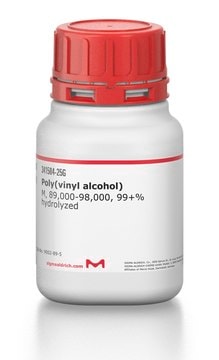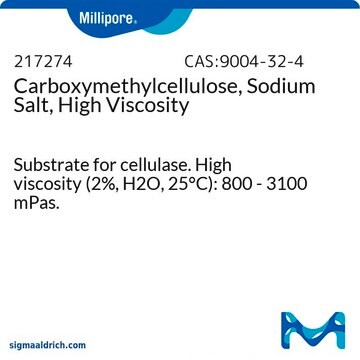419303
Sodium carboxymethyl cellulose
average Mw ~250,000, degree of substitution 0.9
Synonym(s):
Carboxymethylcellulose sodium salt
Sign Into View Organizational & Contract Pricing
All Photos(3)
About This Item
Recommended Products
Quality Level
form
powder
autoignition temp.
698 °F
mol wt
average Mw ~250,000
extent of labeling
0.9 carboxymethyl groups per anhydroglucose unit
mp
270 °C (dec.)
SMILES string
[Na].OC(C(O)C(O)C=O)C(O)CO.OC(=O)C
InChI
1S/C6H12O6.C2H4O2.Na/c7-1-3(9)5(11)6(12)4(10)2-8;1-2(3)4;/h1,3-6,8-12H,2H2;1H3,(H,3,4);
InChI key
DPXJVFZANSGRMM-UHFFFAOYSA-N
Looking for similar products? Visit Product Comparison Guide
General description
Sodium carboxymethyl cellulose (CMC) is a class of linear structured cellulose which consists of polysaccharide composing the fibrous tissue of plants.
Application
CMC can be used for a wide range of application such as:
- food processing, textiles
- detergents, and drugs
- a stabilizer in the preparation of nanoparticles
- a binder for the fabrication of electrodes
Storage Class Code
11 - Combustible Solids
WGK
WGK 1
Flash Point(F)
Not applicable
Flash Point(C)
Not applicable
Personal Protective Equipment
dust mask type N95 (US), Eyeshields, Gloves
Choose from one of the most recent versions:
Already Own This Product?
Find documentation for the products that you have recently purchased in the Document Library.
Customers Also Viewed
Silver nanoparticles as pigments for water-based ink-jet inks
Magdassi S, et al.
Chemistry of Materials, 15(11), 2208-2217 (2003)
Sodium carboxymethyl cellulose a potential binder for Si negative electrodes for Li-ion batteries
Li J, et al.
Electrochemical and Solid-State Letters, 10(2), A17-A20 (2007)
Alan Ransil et al.
Nature communications, 12(1), 6494-6494 (2021-11-13)
Sodium trisilicate waterglass is an earth-abundant inorganic adhesive which binds to diverse materials and exhibits extreme chemical and temperature stability. Here we demonstrate the use of this material as an electrode binder in a lay-up based manufacturing system to produce
In situ synthesis of polyaniline/sodium carboxymethyl cellulose nanorods for high-performance redox supercapacitors
Peng H, et al.
Journal of Power Sources, 211, 40-45 (2012)
Lisa Miclotte et al.
Frontiers in microbiology, 11, 577474-577474 (2020-12-01)
The use of additives in food products has become an important public health concern. In recent reports, dietary emulsifiers have been shown to affect the gut microbiota, contributing to a pro-inflammatory phenotype and metabolic syndrome. So far, it is not
Our team of scientists has experience in all areas of research including Life Science, Material Science, Chemical Synthesis, Chromatography, Analytical and many others.
Contact Technical Service





